PGA Tour Clubhead Lag Part 3 The Release
- by Kelvin Miyahira
Releasing the Lag
Last month’s article should really be the winter’s work for many of you since it’s getting a bit cold now (we’re in the low 80’s for daytime high temperatures). But let me add a few more important micro moves so that we can be clear on how to release your lag. Holding a great lag (<110 degrees at horizontal) is almost 100% fool-proof in terms of avoiding a flip. But there is still a possibility that you can ruin a great lag position therefore not maximizing the stored energy potential and obtaining as stable, repeatable impact release style (drive/holding) as the best on the PGA tour. So let’s take a closer look at all of these micro moves to see the remarkable reality of how many movements are required to be able to do what the best tour players do to obtain optimum power and accuracy.
Let’s start with the left side movements first, then the right side and then moves that occur in both sides. Lastly, I’ll finish off with the micro moves related to the how the clubface should be moving. But first let me make a point that I may not have made clear enough in last month’s article.
Force Couples and Body Rotation
In order to create rotation in the human body for a golf swing we are relying on force coupling. From Answers.com here’s the definition of a “force couple”:
“Two equal, but oppositely directed forces acting simultaneously on opposite sides of an axis of rotation. Since the translatory forces (forces that produce linear motion) cancel out each other, a force couple produces torque (rotatory forces) only. The magnitude of the force couple is the sum of the products of each force and its moment arm.”


Can you see how Jamie Sadlowski instinctively uses his body to produce rotation? The purple lines approximately show the spine position and therefore axis of rotation. Notice the upper body spine tilt is different than the lower body tilt. Thus, there is a lateral bending, which we know from Gracovetsky’s spine engine must exist in order to rotate the body.
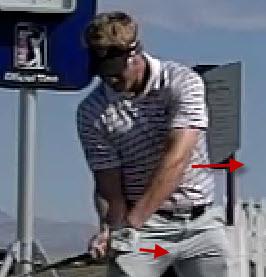

But if you move to post up on the left side (moving to purple line) or slide too far left, you lose a lot of the left side pull and have more of a right side push. This creates an unbalanced set of forces that produce more of a translational (lateral) movement instead. Obviously this produces less rotation of the spine and therefore less rotational speed.
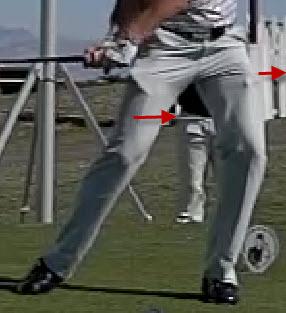
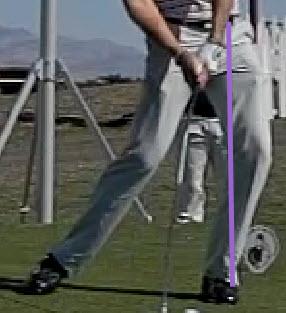
Same with the lower body. Posting up on the left side creates only a right side push and therefore more lateral motion. Could this be why biomechanists looking at the kinetic/kinematic chain see the hips and shoulders decelerating? They are only looking at rotational movements and pretty much ignore the translational movements. Perhaps if they looked for a correlation in the players with the highest translational numbers (sliders), they would find the best decelerators (stallers)!

A recent Southpark episode comes to mind where Eric Cartman’s massively high bodyfat percentage and extremely high cholesterol numbers caused the entire school’s average to look like they were the most out of shape school in the nation. This forced the school to put all the fourth graders on a mandatory exercise program which everyone hated. Of course it’s absurd that one person can change the average for the rest of the 99% and make them appear to be fat as well. Same holds true in golf: the extraordinary swing of Tiger Woods 1999-2001 did not make the other tour players’ swings appear great. Just the opposite.
Thus, we have to think about how many tour players are really using their bodies’ optimally. I can think of Bubba, JB, Gainey, Alvaro Quiros, Dustin Johnson, Keegan Bradley, Scott Stallings, Robert Garrigus, Gary Woodland and maybe a few others are almost optimal (truly optimal is Jamie Sadlowski and other elite level long drive guys). But the few will not change the average like Cartman did. So the question you have to ask yourself is, “do you want to learn what the average tour players does or what the elite tour players do?”
Left Side Movements
Lag Release Micro Move #1 – Left Arm Abduction
Continuing on from last month’s article where we left off after the left trapezius fire, the deltoids will fire to abduct (move the arm away from the center of the body) and create a separation of the left arm from the chest. The pectoral muscles which have been restraining this separation of the left arm from the chest relax and allow the opposing muscles namely the powerful lats and rhomboids to take over. This is all part of stretch shorten cycle actions (stored energy from all the braking) that should not require conscious thought to perform... unless you’ve been trained out of using it by placing gloves or other objects under your left arm to retain the “connection” through impact.
The most stable position at impact requires this separation/elevation!!! If there is no movement to separate, the potential for a last millisecond flip increases tremendously.
Can you see the left arm and chest connection? Thus there is no left arm abduction (moving the arm away from the body and toward the target).
Lag Release Micro Move #2 – Left Shoulder Retraction
Previously, I did not think this movement should exist because I could not see the scapula retracting from back views. But upon further review from the front, this micro move or muscle contraction is definitely at work prior to impact. It can start applying force and move toward retraction but not reveal itself from the back view until far later when the scapula is fully retracted. This movement is seen as the distance between the left shoulder and the chin grows farther apart and the left shoulder joint appears to pull up and back away from the ball.
Of course there are some that do not use the left shoulder retraction and this allows the club to swing past the arms and shoulders. Notice that left arm abduction does not occur as well.
Lag Release Micro Move #3 – Chest Expansion
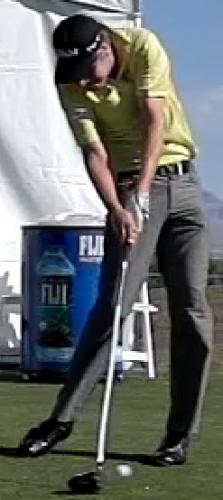
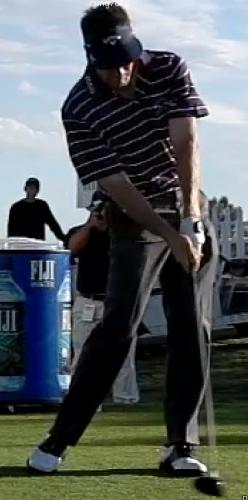
Perhaps this is best seen in still pictures. On the left, can you see what it looks like when you’re just flipping it? Both shoulders are in protraction while the club swings past the hands. Compare with Stuart Appleby on the right that has his chest expanded and left shoulder in retraction as well.
Lag Release Micro Move #4 – Left Shoulder Remains Internally Rotated
Here’s Sergio Garcia keeping his left shoulder internally rotated through impact which keeps the left elbow facing toward the target. There are many muscles at work (or should be) in order to keep the left shoulder in internal rotation (IR). The main muscles are the deltoids, lats, pecs and biceps.
Flippers, rollers and flip/rollers will use their smaller muscles (rotator cuff muscles) to externally rotate the left shoulder which will point the left elbow behind them. See Jeev Milkha Singh above.

Or the left shoulder external rotation can point the left elbow to the ground in a flip/rolling and re-hinging move.
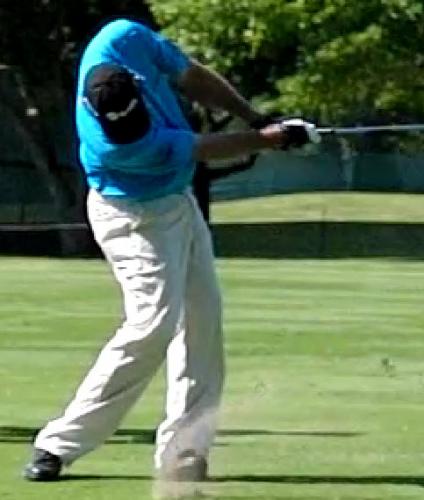
Re-hinging??? Don’t think so.
Note: External rotation of the shoulder will always increase supination of the left forearm through impact whereas by trying to retain internal rotation, the great ballstrikers are seeking to reduce supination.
Lag Release Micro Move #5 – Left arm elevation
This is a very difficult move to isolate due to other body movements occurring simultaneously as well. Many planeologists are only concerned that at impact the club and left arm return to impact at the same spot. This means they do not want arm elevation. Isn’t this a Leadbetter idea?
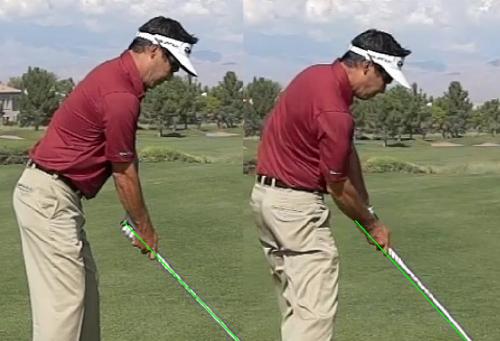
We’ve been told by the planeologists that the key to the kingdom is in returning the club to the same plane that it was at address. Never mind all else that occurs in the swing (flip, roll, stall or whatever else is occurring): if you can bring that club back, you will be rewarded with ball striking beyond your wildest dreams. But it’s just a dream.
The reality is that it is best not to do this for several reasons. One major reason is that this eliminates many micro moves and many muscle firings. Typically, the trapezius won’t fire to tilt the shoulders. The left shoulder retraction won’t occur. Left arm abduction is gone. Chest expansion, a big power move, will be lost. Ulnar deviation, which will be discussed later and is a tremendous stabilizing force for impact will be gone.

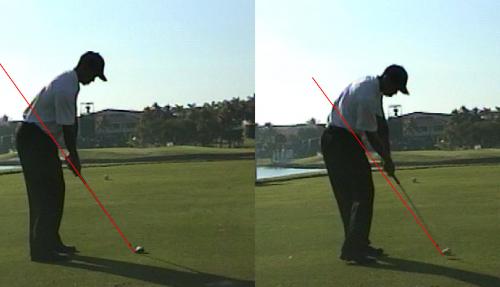
Sorry but there weren’t any affordable high speed cameras back then but can you see how Tiger’s arms were a lot higher post-impact? There was no returning to the plane line, swinging on a singular plane or swinging his arms “low and left” as they say. His hands were far higher and swinging toward the target (vs. low and left) which is evidence of arm elevation.
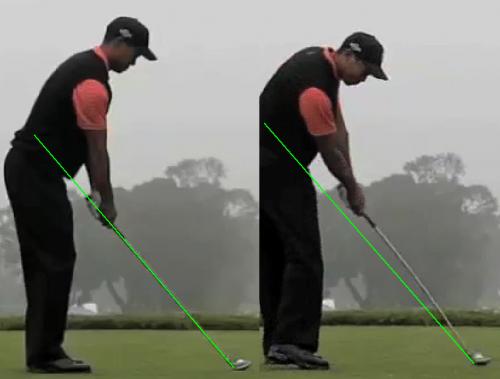
From 2008, Tiger still elevating.
Lag Release Micro Move #6 and #7 – Left Bicep Contraction and Left Arm slightly flexed (bent)
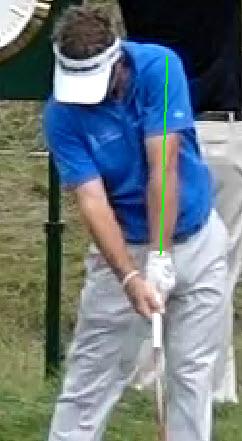
In order to keep one’s left arm perfectly straight (some actually hyperextend the elbow), the left tricep must contract as well as the forearm extensors. This will automatically pull the left wrist into extension (cupping) and therefore invite a flip to occur. How is that so?

A little Anatomy Trains by Thomas Myers might be in order. The forearm extensors are connected to the triceps which are primarily responsible for straightening the arm. Thus, as the triceps contract to pull the arm straight, they are also pulling on the forearm extensors.
The forearm extensors are the extensor carpi radialis longus and extensor carpi radialis brevis. These muscles are inserted into to the dorsal (back) surface of the 2nd and 3rd metacarpal bones (index and middle finger). When contracted, these muscles pull the wrist into extension (cupping) as when doing reverse wrist curls. Do we really want this for your left wrist?
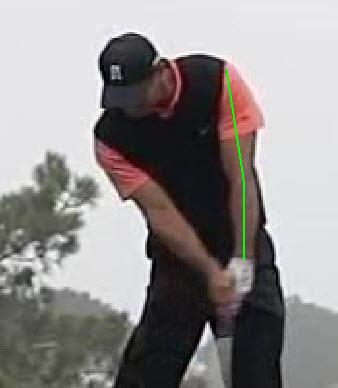
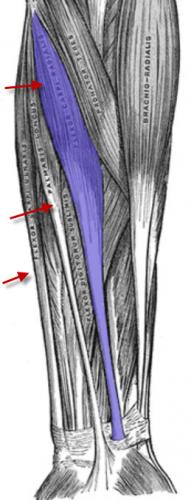
See Tiger’s slightly bent left arm at impact? The left wrist is in a far stronger position due to the contraction of the bicep and the forearm flexors. This will naturally bend the left arm slightly.
The flexor carpi radialis, palmaris longus, and flexor carpi ulnaris are the main muscles working to flex the wrist. Also, the brachioradialis is responsible for supination of the forearm. These muscles are on the inside of your forearm and connected to the anterior (front) of your metacarpal bones (opposite from where the extensors are inserted). Doing a traditional wrist curl will exercise these muscles.
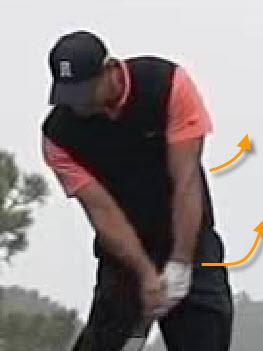
The effect of Tiger’s left bicep contraction and body rotation is to create a pull on the hand and elbow that is up and behind him. Thus, there is some left arm abduction, elevation and left elbow flexion.
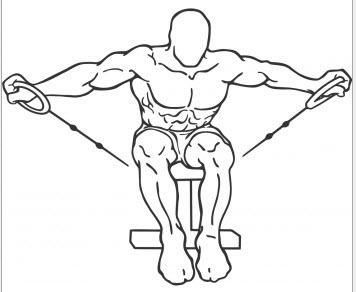
All the left side movements can be seen in a simple exercise like a rear lateral raise while the spine is in a slightly flexed position (bent over). You can use a pulley, dumbbell or rubber tubing for this. The chest expands, the scapula retracts, the left biceps contract, the traps fire, the deltoids raise the arm and all the left arm movements are correct for a golf swing. Simple, no?
Pop Quiz
Let’s see if you’ve been paying attention. So here’s a little quiz to see if you understand what’s going on.
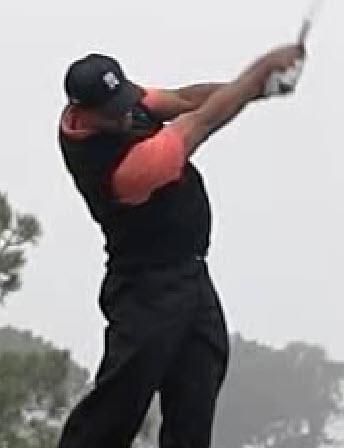
Study this picture and answer the following questions.
- Is his left arm straight or bent at this point?
- What position is his left wrist in? Flexion (bowed) or extension (cupped)?
- What position is his left forearm in? Is it supinated or pronated?
Write your answers down on a piece of paper. I will give you the answers at the end of the article. No peeking.
Right Side Movements
As we saw last month, the goal is to have the right shoulder stay in retraction and external rotation for as long as possible since firing the right shoulder into protraction and internal rotation triggers the arm and hands to release immediately thereafter. As will be discussed below, you don’t want this firing to happen too soon. Also, the right elbow and arm movements are extremely important to get us into position where you can fire at the right time. If the right arm is trapped behind the right hip, there’s going to be some sacrifices made to reduce body rotational speed (stall) in order to get the hands in the right place at impact.
Lag Release Micro Move #8 and #9 – Late Right Shoulder protraction and Internal Rotation (IR)
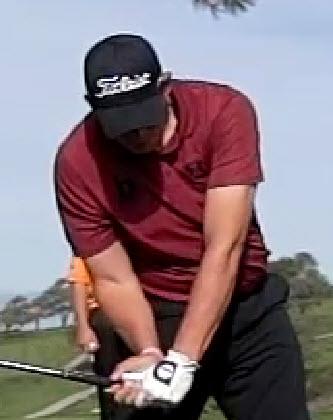

When executed at the correct time, right shoulder protraction and internal rotation triggers right arm extension, right forearm pronation and right wrist flexion. These movements add power and help to square the clubface if timed right. If they comes too early, that causes a flip.
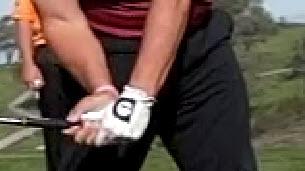

Notice the Golf Pride logo in white begin to appear in the second frame. In the first frame you can see the white lettering is at the 12 o’clock position.
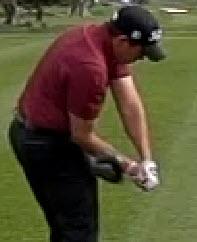
This matches up with Scott Stallings neutral grip and “toe up” position at this point.

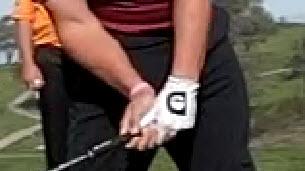
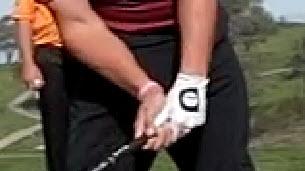
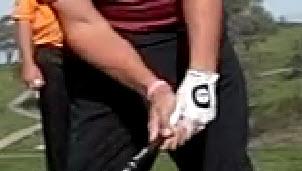
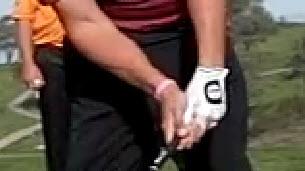
Take a close look at the radial bone of Stallings right forearm rotating all the way till the last frame in this sequence. At this point, his pronation ends and it is just two frames prior to impact. His right arm has extended some but not fully.
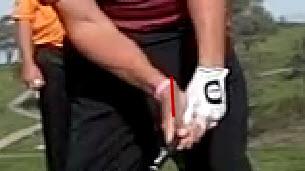
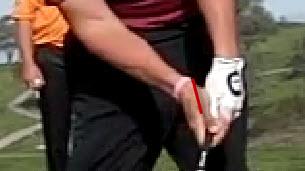
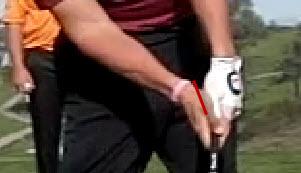
The last two frames show how late the right wrist flexion occurs. Obviously, this assures no flip occurs. The right wrists flexion/left wrist moving toward extension has the effect of slowing the rate of clubface rotation.
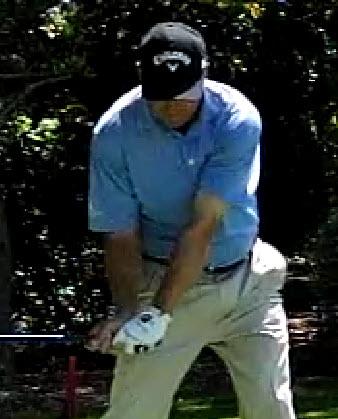
Here’s Olin Browne who has his right elbow behind his right hip due to early right shoulder protraction/internal rotation. Notice how far his right shoulder is from his chin vs. Stallings in the previous pictures.
As you can see, Olin’s right shoulder internal rotation is running out of gas.

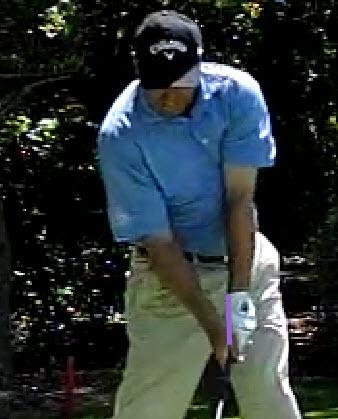

In these three frames the right wrist flexion occurs too early and since there wasn’t enough right forearm pronation in the earlier frames (as there was with Stallings), right forearm pronation must occur just before impact.
Thus, Browne is using right forearm pronation through impact. This is another version of a flip/roll. But this time the roll comes from right forearm pronation and the flip comes from left wrist extension. This increases the rate of clubface rotation (closing) in the last couple of frames before impact. He narrowly escapes a flip but you can see the effect of having the arm a bit too far behind due to early right shoulder protraction and internal rotation.
Rickie has a similar problem and his stall is more evident. Rickie cannot rotate freely with the arm behind because there is no advantage in doing so. If Rickie were to rotate like Dustin or Tommy, his arms would fall farther behind and that would lead to larger errors. Thus, here is a case where the arm and club position affect the timing of the right shoulder protraction and internal rotation (causing it to be early) and ultimately causes a stall.
Lag Release Micro Move #10 – Late Right Arm Extension
The right arm extends to push the grip end forward. If right shoulder internally rotates early, the right arm will straighten prematurely and cannot possibly move the grip end forward because the movement is already used up. When that happens, the only thing left is to add a lot of right wrist flexion (flip) in order to get the clubhead to the ball.
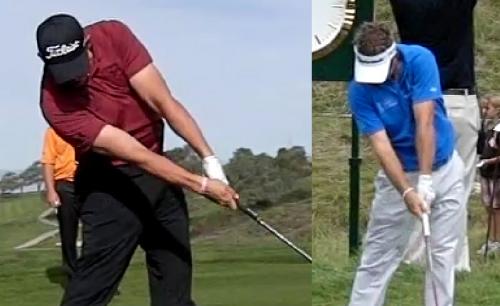
See Stallings extend his right arm fully at about 4 o’clock. If right arm extension and right wrist flexion comes too early...

Does Roger Federer look like he’d be a good golfer?
Forearms, Hands and Wrists
The next few micro moves relate to the squaring of the clubface.
Lag Micro Move #11 – Holding Right Wrist Extension/Left Wrist Flexion

This is part of the pronation/supination of the forearms. Big Break’s James Nitties (white and blue shirt) has his left wrist in extension (and forearm pronated) vs. one of the PGA tour lag leaders Rory Sabbatini (black shirt) has his left wrist flexed (and forearm supinated) just before impact. Also notice how James, who is releasing his right wrist or moving toward flexion vs. Sabbo who has his right wrist extended (cupped).
When right shoulder internal rotation and right arm extension occur too early, that can also close the clubface too early. Thus, imagine closing the clubface early, then adding even more left forearm supination/flexion as you approach impact. The clubface would be so closed that you would smother hook it.
So maybe the flip is a compensatory mechanism once the initial error of early right shoulder protraction and internal rotation occur? It does the job of holding the clubface more open albeit with added loft.
Lag Micro Move #12 – Left Forearm Supination/Right Forearm Pronation
Anatomically, it is important to separate these moves so you can identify and classify them. But in the real world of the human anatomy as it relates to the performance of a golf swing, these moves are occurring in three dimensions. For example, if the right wrist remains fully extended like Sabbatini’s, the right forearm will automatically be more pronated, thus the clubface will be closer to square by virtue of these movements.
On the other hand, if the right wrist moves toward flexion as Brian Gay does, his right forearm will also move toward supination which will leave the clubface more open. Of course, this will necessitate a flip/roll to get the clubface squared.
Is this significant? The repeatability of a swing is highly dependent upon how all these arm/wrist/hand movements are lined up to occur at impact. If one is in Gay’s or Nitties’ position prior to contact, it requires a fast flip/roll in order to square the clubface. Is this repeatable? Perhaps with a lot of practice and daily beating of 1000’s of golf balls. Is it going to hold up under the pressure of a final round? Maybe this is why we have one-hit wonders that play out of their minds when the moon is in the seventh house and Jupiter aligns with Mars. One-hit wonders can win majors as we have seen. But is it legendary? Is it even capable of high performance so that making one’s tour card each year is possible?
So it begs the question, what good is it to have lucky impact that has the face square, path zeroed out, attack angle perfect, etc. if you can’t repeat it??? If the path to a straight shot is the lucky one in 1000 in getting the timing perfect, then how will the rest of the 999 shots fly? You don’t want to be an accident waiting to happen. Get these micro moves mastered and you will be rewarded with a swing that does not require so much practice. Then you can practice your putting and short game to allow yourself to truly benefit from better ballstriking.
Lag Release Micro Move #13 – Left Wrist Extension/Right Wrist Flexion
This move is not really the one to worry about. In fact this should be considered a nano move because this should happen within the last 15 milliseconds prior to contact. Everyone does this move. Even the most extreme laggers use this move. The problem is that this happens way too early in the downswing for most people and we call that a flip.
As the right shoulder internally rotates and the right arm extends, that will naturally cause right wrist flexion. This is the last segment to fire. If there is a place for the segment interaction principle or the kinetic chain to exist, it is in the arms, wrists and hands.
What does this really mean?
The great players do not wait till the last 10-20 milliseconds to supinate/pronate to square the clubface: by then they have already complete all these micro moves. This last segment firing is what slows the clubface rotation rate while allowing the clubhead to catch up to the hands (hopefully without passing though).
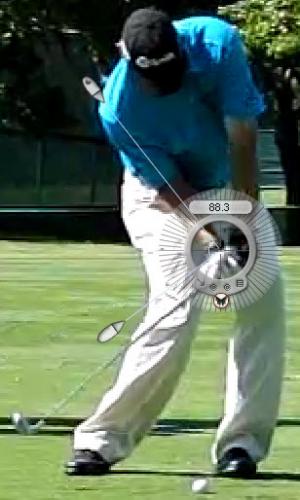
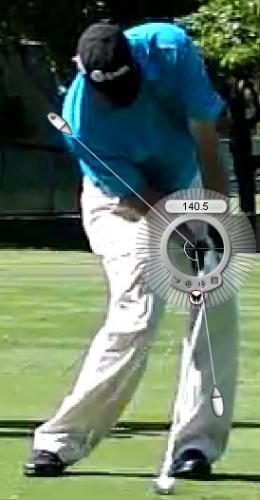
Gainey’s right forearm to wrist angle changes around 52 degrees (although one must be careful since there are 2D distortions) in four frames leading up to impact! This gives you a rough idea of how he uses right wrist flexion to increase speed while the left side movements are minimizing the amount of left wrist extension since he does arrive at impact with huge shaft lean.
Lag Release Micro Move #14 – Ulnar Deviation (UD)
If ulnar deviation occurs too early, it will decrease lag.
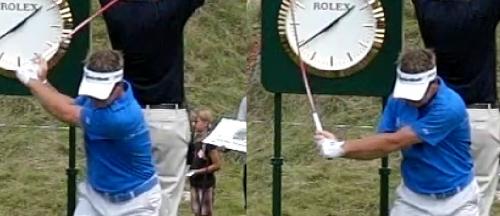
This is increasing ulnar deviation early.
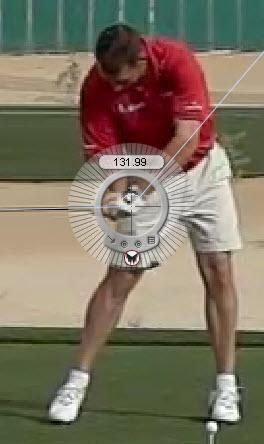
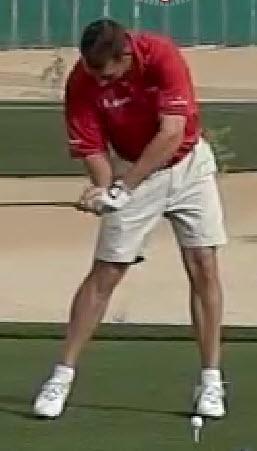
Here’s Lee Westwood with early UD.
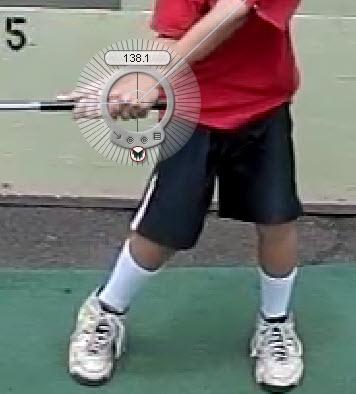

For most players, moving the wrists into ulnar deviation too early is pretty disastrous. If you’ll notice, early UD causes the left wrist to move toward extension early and the right forearm to supinate. The result is a massively open clubface with about a foot and a half of distance before impact. Many amateurs with fading/slicing problems look similar to this. See how open the clubface is about a foot and a half prior to contact?
On the other hand Lee Westwood might be in early UD but does not allow the clubface to be this open. Lee uses some left forearm supination to get his clubface squared early vs. the amateurs with similar early UD who supinate the right forearm instead.
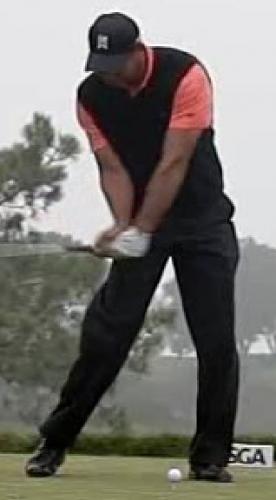
So we know that Tiger is holding radial devation (opposite of UD) until this point.
Then you can see that he moves to UD at impact. The UD plus arm elevation causes his hands to move slightly up and toward the target.
Body Movements
Lag Release Micro Move #15 – Ab Contraction
In martial arts there is always a powerful exhalation during a punching or kicking motion. This undoubtedly is related to an abdominal contraction and a lower pectoral contraction that aids in punching power. Thus it makes perfect sense for this to be part of a golf swing as well.
Take a look at the excessive midsection slide by Ricky Barnes. This means his abdominal muscles are relaxing instead of contracting. Perhaps this is why he needs to have the body of a NFL linebacker?
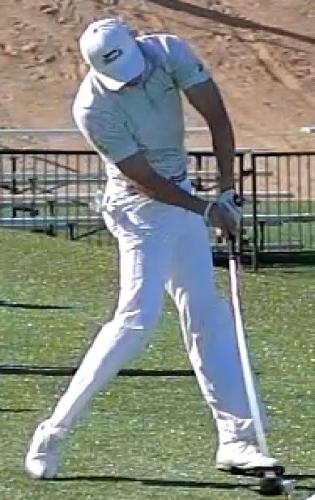
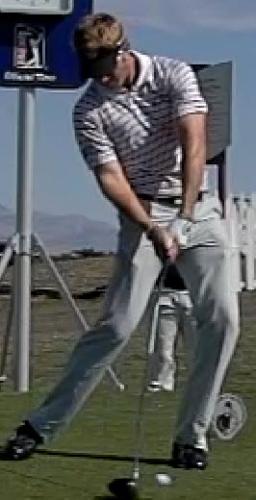
Also, the abdominal muscles are related to the hip adductors firing that create more rotation in the hips. Is Ricky missing something here?
Lag Release Micro Move #16 – Spine Rotation!!!
Some teachers and all biomechanists believe that after the hips start the downswing, they need to decelerate to allow the obliques to rotate the upper body through. That may be happening in many amateurs but majority of the PGA tour players are definitely not doing this.
Watch this animation of JB Holmes and see if his spine stops rotating before impact. Thanks to Brandon Parsons for this fantastic video! Risked life, limbs and Casio EX-F1 camera to get this shot.
Notice in Rickie’s swing, he does stall the lower body and this forces the disconnection between upper and lower halves of the body. Even with a stall of his hips though, the notion of obliques to start firing after the hips start the downswing is not recognizable in any way. The spine is driving this swing and his upper body passes his lower body AFTER impact.
Upper Body Rotation is not Spine Rotation
As we have seen with JB Holmes and others, spine rotation should be defined as the entire spine rotating through impact. Take a look at the video below.
Tale of Two Johnsons
Many people are confused about this even those on tour. One might casually look at Zach Johnson’s swing and think he has a lot of body rotation. But does the rotation come when he needs it? And one might look at Dustin’s follow through and sense a stall. So the key to all of this is when these events take place.
Does this make sense now? Isn’t the whole point of the swing to put all your energy into the ball and then after you’ve made contact, you’ll reach the end of your motion and you can just relax/decelerate? Whereas with Zach, what’s the point of rotating so hard after the ball has gone? This increases the chance for injury to the spine (this shall be discussed fully in a later article) as well as having no possibility of adding to the impact of the ball.
Connection of spine gears vs disconnecting.
Perhaps this is what some people are talking about when saying that the hips must fire, and then decelerate to create a transfer of energy to the shoulders and arms. But hey, they’re preaching to the choir. Everyone can do that. What they can’t do is what the great players do and rotate their ENTIRE body through impact before slowing down.
Lag Release Micro Move #17 – Head Movement
Increasing right lateral bend during the downswing will cause the spine to tilt to the right. This will pull the head back (away from the target) and may even move the head a bit toward the ball if one’s body is rotated as much as Graeme. This helps to increase the chances of hitting the driver with a positive attack angle.
Low Point of your swing and shallowing the attack angle

Most of the extreme laggers on the tour share some common traits. They have more shaft lean at impact thus have tendencies to have a more exaggerated negative attack angle (club hitting down at the ball). This is excellent for hitting irons but is this good for hitting your driver?
Well, most of them also have their heads moving away from the target at impact (due to lateral bending that keeps the spine gears connected). This allows them to shallow out their attack angle and hit up on the ball with the driver which helps to maximize their driving distance from their given clubhead speed.
Contrast that to the flippers like Rickie, Lee, Brian and others who have their chest more over the ball (or chest covering the ball). They have more weight on their left sides at impact. One could even say “posting” on the left side. This would also increase their negative attack angle (fat avoidance compensation) which wouldn’t be good but they “fix” that by flipping the head forward at impact. If you look at their spine positions at impact, Rickie has his head more over the ball at impact making his spine closer to vertical vs. Scott who has his head falling back more and therefore has more tilt to his spine.
Tour Striker and Trackman
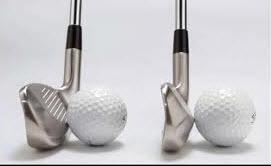
This brings me to an interesting dilemma. We’ve seen the infomercial for the Tour Striker hundreds of times and it makes a lot of sense to have a club like this. But does it really tell you if you’re doing this right or not? Hmmmm.
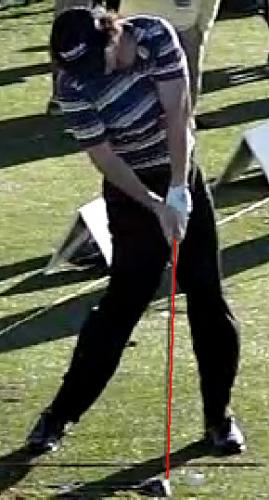
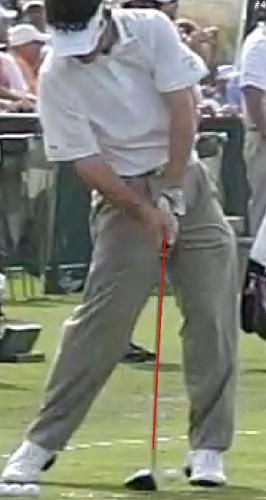
Here’s Rory McIlroy on the left and Louie Oosthuizen on the right. Both are captured just after impact (you can see the ball is only inches away from the clubhead). Louie’s shaft is leaning 3.5 degrees forward after impact. Rory’s shaft is just over 2 degrees leaning forward at the same spot. Louie’s is flipping and sliding while Rory is drive/holding, rotating without sliding and has his head falling back. Yet, if you’re just looking at the shaft lean, Louie has more! How odd... doesn’t that mean Louie would have an easier time hitting the Tour Striker Pro model? Would it fix his flip???

And Trackman. I love technology as much as anyone. But here’s a good question for Trackman lovers, how does trackman know if you’re doing this right or not? If a flipper can move his/her upper body toward the target (chest covers the ball), he/she can achieve the same numbers as an extreme lagger that leans back and uses parametric acceleration!!!
The club can be doing the same thing but if the technology doesn’t distinguish the flipper from the extreme lagger how effective a teaching tool can this be??? Wouldn’t we want a tool that clearly defines the great from the not so great?
Also, if Trackman can measure the clubface conditions at impact so well, why can’t it measure it 12” to 18” prior to contact and calculate the clubface rotation rate in that critical part of the swing (from there through impact so it could help someone like Phil)??? Also, since it is so accurate, why stop at the clubface and head? Why not measure how the shaft angle changes from pre-impact to post-impact? That would help separate the flippers from the drive/holders by measuring the rate of change in shaft lean through impact.
Mix and Match
What happens when extreme laggers like Tiger move too far left?
Does this not increase his shaft lean at impact with his driver? His shaft is 3.5 degrees forward at impact and must be giving him a huge negative attack angle at impact since his body is so far left (doesn’t fall back as much) compared to his glory years. Could he be going down the same path that Aaron Baddeley did when he had a negative attack angle of 6 degrees with his driver while stacking and tilting? Badds could only fly it 250 yards with his driver at that time which would be great for any amateur but was difficult to compete on the PGA tour with the loss of his driving ability?
Parametric Acceleration
The internet golf world is buzzing over an idea called “parametric acceleration.” It is a study done by Koryo Miura that describes a different way of moving your body in order to add more kinetic energy and velocity to your club. But the double pendulum model is too simple for what actually goes on in an athletic golf swing leaving the possibility for people without anatomical knowledge to misinterpret these findings.

From Miura’s paper, here’s a diagram of how the hands should move to use parametric acceleration to add power to impact. As he says, “clubhead velocity could be increased substantially by the inward pull motion of the club at the impact stage, at which point no other means of acceleration is available.”
Okay, so this sounds really good. How do you apply this theory to add power to your swing? Where does this inward pull come from? His answer, “The pull might be closely relating to the aggressiveshift of the left shoulder.” So how do you move your left shoulder???
This is where some understanding of the how the human body functions during a swing is necessary. Rick found this move in JS over three years ago and only now we truly know how this movement functions with regards to the muscle firings and joint movements.

If you’ve read this far and really want to know how to use parametric acceleration in the golf swing, you’re already there! Here are the release micro moves used to obtain this “aggressive move of the left shoulder”:
Left Trapezius pulling up
Left shoulder retraction
Chest expansion
Left bicep flexion/left arm bent (not actually affecting the left shoulder but surely the hands)
Internal rotation of the shoulder powered by the chest and the lats
Head movement away from target
These moves are the ones that are powering the up and in pull of the hands because they have a direct influence on the “left actuator” as Miura calls it.
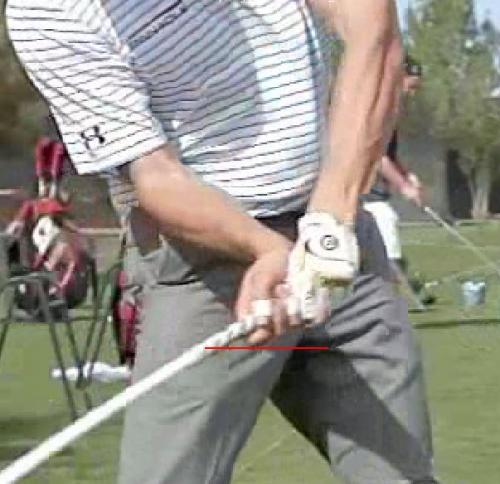
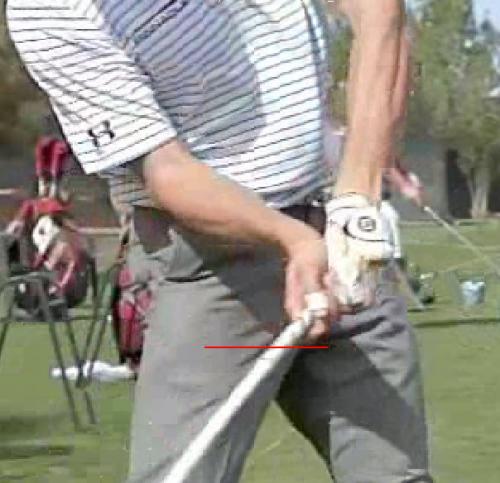
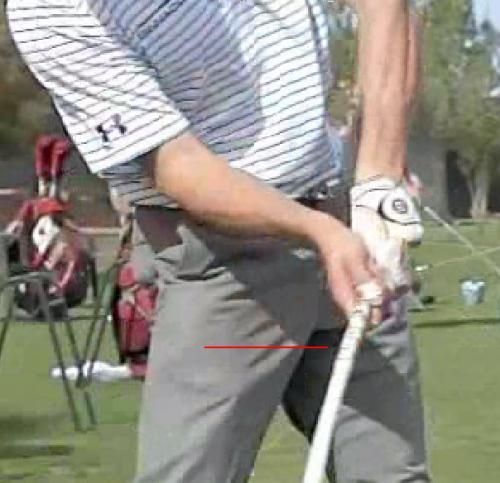
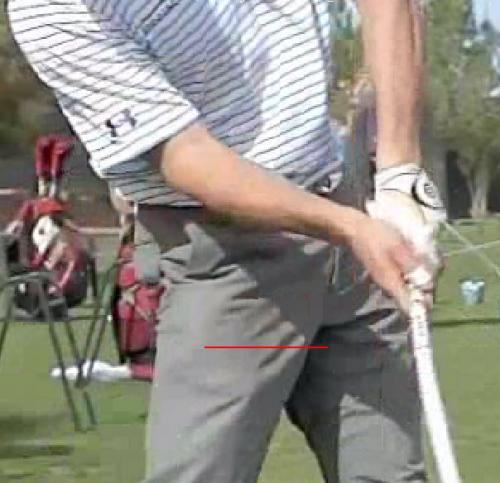
Then you can really see this on JS as his hands are much higher up and in at impact following Miura’s model.

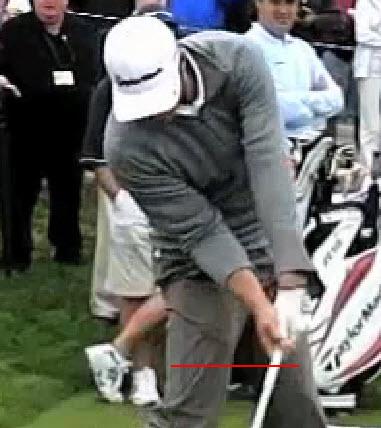
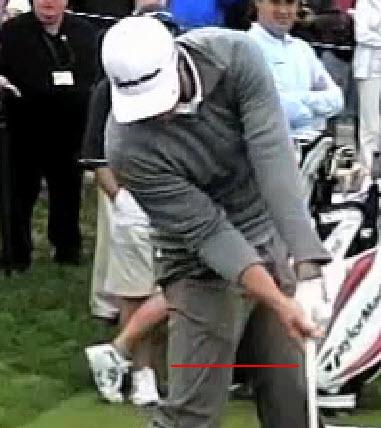
DJ has a little less parametric acceleration than JS.
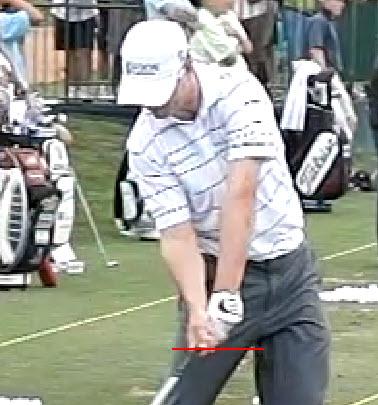
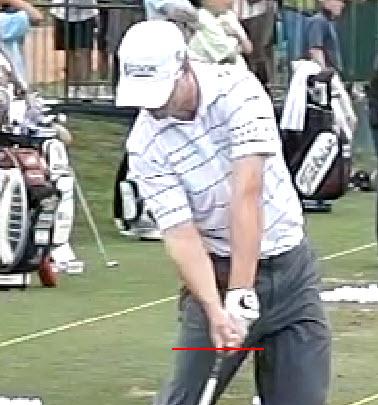
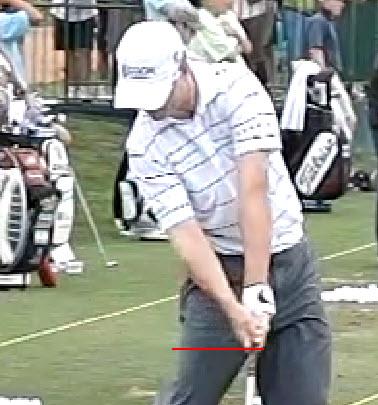
Zach has barely any.
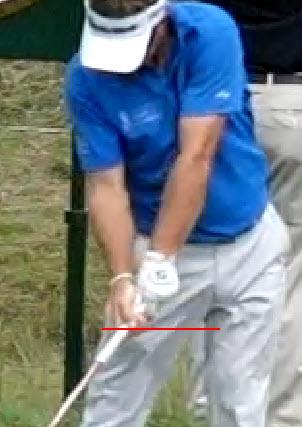
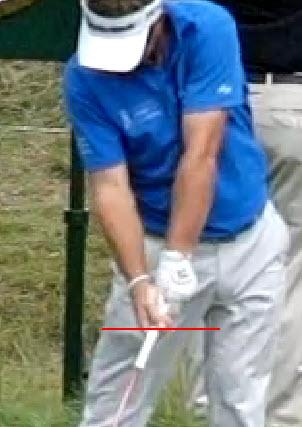
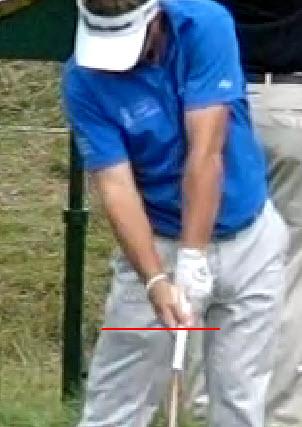
None.
Some people might think that guys with extreme lag will not use parametric acceleration. Not!
Miura goes on to say that “the coordination of the quick rotation of shoulder/waist and the quick lifting of the left side of the body generates the inward pull motion.”
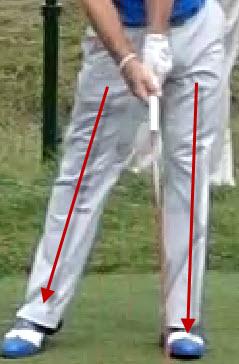
Once again, this rather vague statement can be misconstrued and have people pushing into the ground in an attempt to lift the left side of the body……..leading to a stall.

We already know the mechanisms of how the waist (as Miura says) or hips turn from my previous articles. There is not a lot of pushing into the ground to straighten the left leg (or even the right leg as Brian does). It straightens more from the pull of the hamstrings and glutes (which extend and rotate the hips as well) vs. using the quadriceps to push down. Also we know that the adduction and internal rotation of the hips provides the rest of the rotational energy from the lower body.
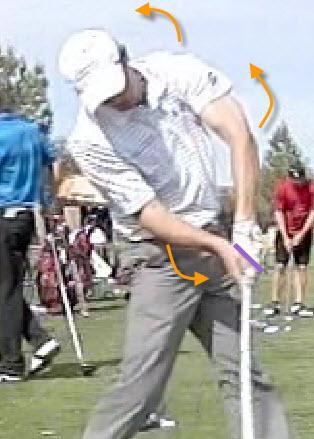
As to rotation of the shoulder, well, we know shoulders don’t really turn. The left retracts and the right protracts in order to create what everyone calls “shoulder turn.” And Jamie adds all the other micro moves to help create more parametric acceleration.
What’s also important to note is that the left side movements are balancing the powerful movements of the right side. If one holds lag like JS or Gainey, then pulls with the left side as previously described, they can add the power of the internal rotation of the right shoulder, right arm extension and right wrist flexion in the last milliseconds while avoiding a flip.
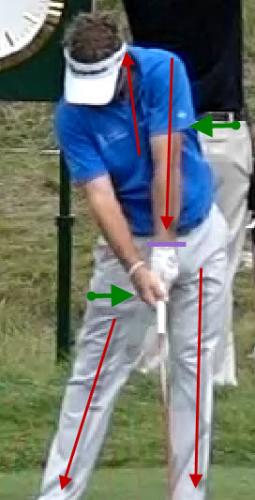
In contrast, if you are just going to extend both arms early, restrict shoulder turn and then to push into the ground to lift your left shoulder by extending the entire spine (also hips and knees in this case) and then use right wrist flexion/left wrist extension to pour on the power of the wrists to aid in the uncocking of the wrists (positive torque), you will lose the balancing effects of the left side movements pulling away. Do you see the traps pulling? Left shoulder retraction? Left elbow pulling away? Since the left arm is straight and trying to stay connected to the chest, there is a force pulling the left arm in the opposite direction of the target (see green arrows). Doesn’t this hinder parametric acceleration and create a flip? Oddly some experts have misinterpreted the science and actually recommend doing these moves to obtain parametric acceleration. And it’s just creating a flip.
Pop Quiz Answers
The answer is, you cannot tell from the front view! But you can from the target line view.
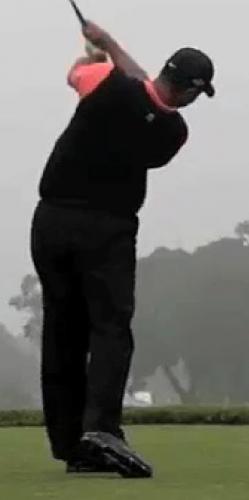
- Bent
- Cupped or extended
- Pronated
The key to understanding what Tiger did is that the great ballstrikers find a way to limit clubface rotation or reduce the rate of clubface rotation through impact. That is why his left forearm stops supinating and works in the opposite direction to pronate.
One could say they get the clubface squared early and hold it square through impact vs. moving the clubface from open to closed then keep closing which is a common notion.
Bottom Line
As you can imagine with a Bell curve, we have extreme laggers on one side, flippers on the other side and the majority of tour players in between. I have shown the extreme laggers because I believe it is good for obtaining a good blend of distance and accuracy (and Tiger, Jack, Ben, Sammy and Arnie were dominant with both distance and accuracy in their primes). Though many golfers can aspire to be like them, the reality is that most will not. But we must shoot for the stars and if we don’t quite make it, we’ll at least reach the moon. And I believe many of you would be perfectly happy with an “average” PGA tour players swing and ballstriking.
Thus, the way to use this massive amount of information about lag and lag release to benefit your golf swing is to take a video and start to look for root causes of your loss of lag. Try doing a couple of themicro moves from last month’s article to create the negative torque (braking moves) because we know that most of you are applying positive torque way too early. Once you learn the braking moves, you will begin to understand that the gas pedal is on the spine: the engine that drives the pelvis and the entire upper body. Revving that engine while holding the brakes will allow a massive, explosive release that will have you firing the entire body, hands and club at impact milliseconds before impact.
Science of Golf
www.jssm.org/vol6/n2/1/v6n2-1pdf.pdf
For all of those that believe in biomechanics in golf, perhaps you should read this review study of the soccer kick. As you read, you will find the soccer kick defined in the segmental and joint rotations in multiple planes as well as the simplified proximal to distal patterning of segment angular velocities (kinetic/kinematic chain). You will find qualitative biomechanical terms for hip movement like extension, flexion, adduction, abduction, internal and external rotation with their joint angle ranges as well as their velocities in degrees per second.
Where are we in the science of golf in relation to soccer when we are measuring velocity of “hip turn” and “shoulder turn” as a sum of all the moving parts that move them??? Is the approach used to analyze a soccer kick too complicated for golf biomechanists?
Why did soccer biomechanists choose to measure all these individual components instead of just lumping them together into hip rotation, leg and foot speed? Wouldn’t that be the same as golf biomechanists measuring only shoulder, hip and arm speed? The oversimplification and lack of qualitative detail of the movements renders golf studies much less useful to the golfer trying to learn a golf swing (and teachers trying to teach a swing). And how did these soccer scientists know what to measure? They studied high speed video to decipher the hip flexion/extension, adduction/abduction, external and internal rotations that were occurring and so on. Once they knew what the movements were, they could then devise the correct methodology (which just so happens to be 3D cinematographic techniques) to measure it.
As I have said before, putting one sensor near the base of your neck to measure shoulder turn and another sensor on your lower back does not adequately tell you what your shoulders and hips are doing or what they should be doing (nor does it even measure correctly). Or even what Miura suggests with the left shoulder actuator is vague. He does not tell you how that shoulder should move. This body of work I’ve laid out in the past few months is in plain and complex (ha ha, thought I would say simple?) universal anatomical language that anyone around the world should be able to understand with some study. This is where the future of science research in golf needs to move toward if it is to actually help golfers.

